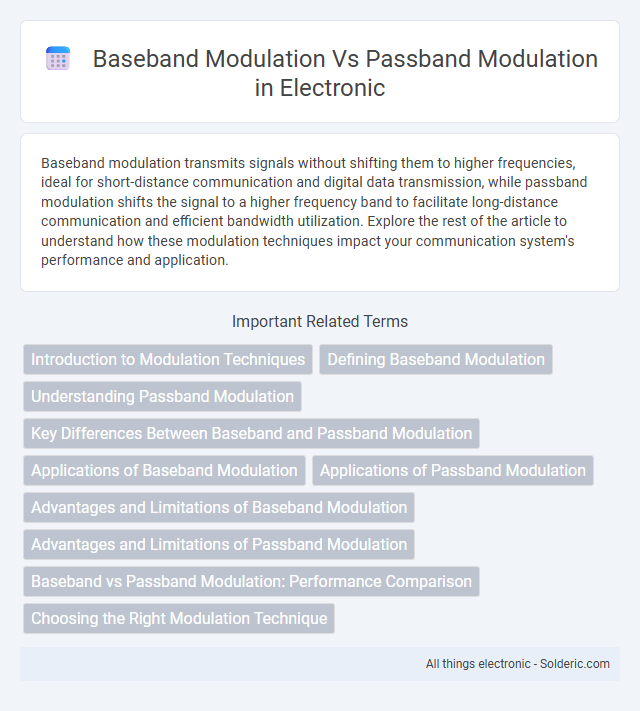Baseband modulation transmits signals without shifting them to higher frequencies, ideal for short-distance communication and digital data transmission, while passband modulation shifts the signal to a higher frequency band to facilitate long-distance communication and efficient bandwidth utilization. Explore the rest of the article to understand how these modulation techniques impact your communication system's performance and application.
Comparison Table
| Feature | Baseband Modulation | Passband Modulation |
|---|---|---|
| Definition | Modulates digital signal without changing frequency; uses original signal bandwidth. | Modulates signal by shifting it to a higher frequency carrier wave for transmission. |
| Frequency Range | Low frequency, near zero Hz. | Higher frequency bands, suitable for wireless and long-distance communication. |
| Applications | Wired communication, LANs, digital baseband data transmission. | Radio, TV broadcasting, cellular networks, satellite communication. |
| Signal Type | Non-frequency shifted digital signals. | Frequency-shifted analog signals carrying digital or analog information. |
| Bandwidth Utilization | Uses bandwidth equal to signal bandwidth. | Requires wider bandwidth due to carrier frequency. |
| Noise Sensitivity | Higher noise interference, suitable for short distances. | Less noise interference, better for long-range communication. |
| Complexity | Simple transmitter and receiver design. | More complex modulation and demodulation hardware/software. |
Introduction to Modulation Techniques
Baseband modulation involves transmitting signals without shifting their frequency, typically used for digital data transmission over short distances like Ethernet cables. Passband modulation shifts the baseband signal to a higher frequency carrier wave, enabling efficient transmission over long distances or wireless channels such as radio or cellular networks. Understanding these modulation techniques helps you choose the appropriate method for optimizing signal quality and bandwidth in communication systems.
Defining Baseband Modulation
Baseband modulation involves transmitting a signal without shifting its frequency spectrum, typically sending data in its original form directly over a channel. It is commonly used in wired communication systems where the entire bandwidth of the channel is dedicated to the signal, enabling efficient and straightforward data transmission. Your choice between baseband and passband modulation depends on the communication environment and system requirements, as baseband suits short-range, low-frequency applications.
Understanding Passband Modulation
Passband modulation involves shifting a baseband signal to a higher frequency carrier wave for efficient transmission over communication channels. This technique enables the simultaneous transmission of multiple signals within different frequency bands, enhancing bandwidth utilization. Understanding passband modulation helps you optimize wireless communication systems by reducing interference and improving signal clarity.
Key Differences Between Baseband and Passband Modulation
Baseband modulation involves transmitting signals without shifting them to a higher frequency, making it suitable for short-distance communication like LANs. Passband modulation shifts the baseband signal to a higher frequency range, allowing long-distance transmission over wireless or cable channels. Your choice between these depends on factors such as bandwidth efficiency, channel type, and transmission distance requirements.
Applications of Baseband Modulation
Baseband modulation is primarily used in digital communication systems such as Ethernet and local area networks (LANs), where signals are transmitted without frequency shifting across a single communication channel. It is essential in short-distance communication applications like computer-to-computer data transfer and high-speed data links due to its simplicity and low power consumption. Baseband modulation also supports signal processing techniques including pulse code modulation (PCM) in telephony and data encoding for serial communication interfaces.
Applications of Passband Modulation
Passband modulation is widely used in wireless communication systems, including radio broadcasting, satellite transmission, and cellular networks, where signals must be transmitted over high-frequency carrier waves. It enables efficient use of the frequency spectrum and allows for multiplexing multiple signals on different carrier frequencies, enhancing bandwidth utilization. Your communication devices rely on passband modulation techniques to achieve long-distance transmission and robust signal integrity in noisy environments.
Advantages and Limitations of Baseband Modulation
Baseband modulation offers the advantage of simpler transmitter and receiver design due to direct transmission of the signal without frequency shifting, making it ideal for short-distance communication and digital data transmission such as Ethernet. However, its limitation is susceptibility to noise and attenuation over long distances, requiring repeaters for signal regeneration and making it unsuitable for wireless communication where passband modulation techniques provide better performance by shifting signals to higher frequency bands. Baseband modulation also faces bandwidth limitations, constraining its application in high-frequency or broadband transmission systems.
Advantages and Limitations of Passband Modulation
Passband modulation offers the advantage of enabling the transmission of signals over long distances using high-frequency carrier waves, which supports efficient use of bandwidth and allows multiple signals to share the same transmission medium via multiplexing. It enhances signal robustness against noise and interference compared to baseband modulation, especially in wireless communication systems. However, passband modulation requires more complex transmitter and receiver designs, including coherent demodulation and carrier synchronization, and may suffer from increased power consumption and hardware costs.
Baseband vs Passband Modulation: Performance Comparison
Baseband modulation transmits signals without shifting the frequency, optimizing bandwidth efficiency for short-distance communication and digital data transmission such as Ethernet. Passband modulation involves shifting the baseband signal to a higher frequency, enabling long-distance wireless communication and better resistance to noise and interference in systems like radio and cellular networks. Performance comparison shows baseband modulation excels in minimizing complexity and power consumption, while passband modulation offers superior coverage and multiplexing capabilities essential for modern communication infrastructures.
Choosing the Right Modulation Technique
Selecting the appropriate modulation technique hinges on the communication system requirements, bandwidth limitations, and channel characteristics. Baseband modulation suits short-distance, low-frequency applications with simpler hardware and minimal spectrum usage. Passband modulation, including AM, FM, and QAM, excels in long-distance, high-frequency transmissions, offering better noise immunity and compatibility with RF channels.
baseband modulation vs passband modulation Infographic

 solderic.com
solderic.com